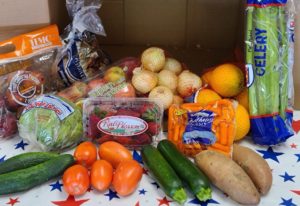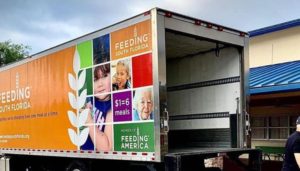Jon Stepanian had some great ideas about how to impose social distancing at the five large weekly food distributions he oversees throughout Long Island and Brooklyn, including having clients show up within certain time periods, depending on their age.
Those good intentions, however, have not necessarily translated into streamlined distributions on the ground for Community Solidarity, the massive vegetarian hunger-relief program Stepanian heads up. With the amount of people needing food doubling, reaching up to 900 in some locations, and without a direct line of communication to give clients a heads-up about new distribution methods, changing gears has been difficult.
“It’s a big learning curve,” said Stepanian, President and CEO of Community Solidarity. “We’re doing our best in a horrible situation.”
Attempts to keep clients at least six feet apart during the Covid-19 crisis are especially important amongst the vulnerable populations served by hunger-relief agencies. Food-insecure people tend to be less healthy to begin with and often elderly, making them more susceptible to the virus. In seeking to make their distributions safer, food banks and pantries are exploring every option.
Client choice methods, in which clients shop for food as if in a grocery store, are increasingly out of the picture. Pantries instead are pre-packaging food into grab-and-go bags that can be quickly handed out, either at the door or at open-air or mobile distributions. Even better is being able to create a drive-through.
As the Three Square Food Bank of Las Vegas phases out its smaller, mostly senior-run pantries in favor of hosting a greater number of mobile distributions around its region, it is encouraging people to drive up, rather than walk up, said Jodi Tyson, Vice President of Strategic Initiatives. “This is the first time we’re really pushing hard on the drive-up model,” Tyson said. “It’s best to maintain a distance and a vehicle is a good way to do that.”
But not every place has that option. Most of the people who come to the distributions held at Daily Bread Food Bank’s warehouse do not have a car, noted Neil Hetherington, CEO at the Toronto-based organization. So Daily Bread has devised a conveyor belt system in which prepackaged boxes shuttle from the warehouse to a large outdoor medical tent housing volunteers. The volunteers, in turn, send the boxes down a second conveyor belt to clients who can remain several feet away.
The set-up helps to keep the warehouse workers apart from the tent workers, as well as the clients apart from all the staffers. A greeter helps to maintain distance between clients in line, and because choice has been eliminated, the line moves faster and doesn’t tend to bunch up much anyway, Hetherington said. “This is not what we want to be doing,” he noted. “Normally we have a shopping model.”
At some pantries, online reservation systems are helping to spread out the times that clients show up. West Side Campaign Against Hunger is among about 200 pantries in New York City using an app from Plentiful that automatically reminds clients when to pick up their food, based on the reservation they made during their last pantry visit. More than ever, WSCAH is finding the app useful in staggering appointment times between clients, said Greg Silverman, Executive Director.
During the week of March 16, WSCAH used the app to inform clients that it would be closing for three days to disinfect its operation, after finding out that a staff member of its landlord had been in contact with someone with the virus. The vast majority of clients got the message through Plentiful and did not show up during the three days. “The app gives us an incredible ability to reach out, which is a hugely important aspect of social distancing,” Silverman said.
Situations like the one at WSCAH have caused the volume of text messages going across the Plentiful app to zoom since the crisis began, said Bryan Moran, who oversees Plentiful as Director of DevOps at City Harvest. Text messages from clients to pantries are up 150%, while pantry-driven messages are up 500%, he said. “On an average week we have about 15,000 pantry messages,” Moran said. “Last week we had 130,000.”
CAPTION ABOVE: Daily Bread Food Bank volunteers, working in a tent, accept emergency food shuttled in by conveyor belt from the nearby warehouse.














